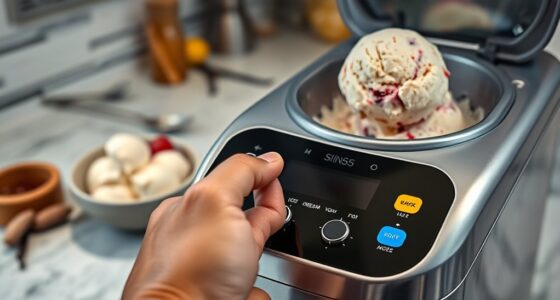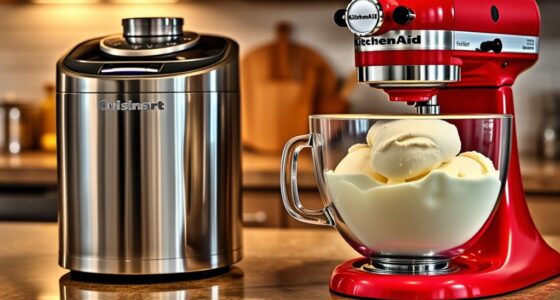If you’re making mistakes with your ice cream machine right now, it’s likely because you’re neglecting proper cleaning and maintenance, using incorrect ingredient ratios, or skipping the essential step of thorough chilling before churning. Overfilling or underfilling, not pre-freezing the bowl (if needed), and rushing the process can also ruin your results and shorten your machine’s lifespan. Keep these tips in mind, and discover more ways to perfect your ice cream craft.
Key Takeaways
- Neglecting regular cleaning and maintenance can cause mechanical issues and affect ice cream quality.
- Using incorrect ingredient ratios leads to icy, soft, or greasy textures.
- Not pre-freezing bowls and mixture properly results in inconsistent, grainy ice cream.
- Overfilling or underfilling the machine can cause spillage, uneven churning, and damage.
- Improper storage after freezing degrades texture, flavor, and shelf life.
Neglecting Proper Cleaning and Maintenance

Neglecting proper cleaning and maintenance can cause your ice cream machine to malfunction or produce subpar ice cream. Regularly check and calibrate the machine to ensure it operates at the correct temperature and consistency. If you overlook calibration, you risk inconsistent texture and quality. Additionally, avoid making ingredient substitutions without adjusting the machine accordingly. Using different fats, sugars, or stabilizers can impact how the machine runs and how the ice cream freezes. Clean all parts thoroughly after each use, especially the mixing chamber and blades, to prevent buildup that can cause mechanical issues. Well-maintained equipment runs smoothly and creates better ice cream, saving you time and future repairs. Proper care is essential for consistent results and extending your machine’s lifespan.
Using Incorrect Ingredient Ratios

Using incorrect ingredient ratios can considerably affect the texture and consistency of your ice cream. If your ingredient balance is off, your ice cream may turn out too icy, too soft, or overly creamy. Accurate measurements are vital to achieve the desired smoothness and richness. Skipping on enough sugar or stabilizers can cause ice crystallization, while too much fat can make your batch overly greasy. Always follow your recipe precisely to guarantee proper ingredient balance. Even small deviations can lead to inconsistent results and disappointment. Remember, recipe accuracy isn’t just about flavor—it directly impacts the texture and overall quality. Proper butter production techniques can help prevent issues like leaks and uneven textures in your ice cream process. Additionally, understanding Bitcoin IRA options can help diversify your assets and secure your financial future. Being aware of product formulations ensures you use ingredients in the correct proportions for optimal results. By paying close attention to ingredient ratios, you’ll produce ice cream that’s perfectly creamy, scoopable, and delicious every time. Maintaining consistent mixing techniques ensures uniformity in texture and prevents unwanted crystallization.
Forgetting to Chill the Base Thoroughly
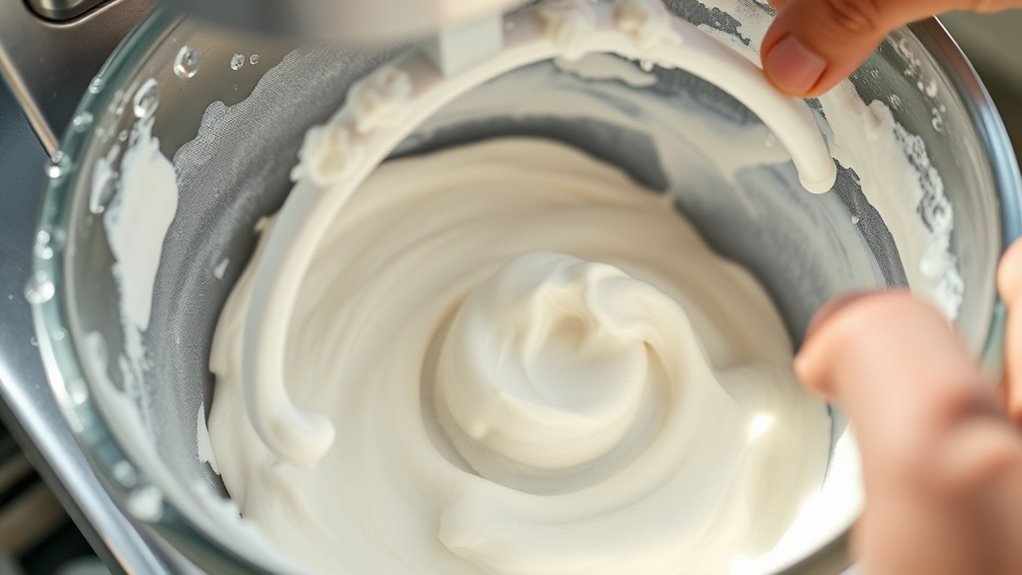
Failing to chill the ice cream base thoroughly can cause your mixture to freeze unevenly and develop unwanted ice crystals. The key to avoiding this is mastering the chill technique, which involves cooling your base to the right temperature before churning. Proper temperature control guarantees the mixture has the ideal consistency, promoting smooth, creamy results. If your base isn’t cold enough, the ice cream may become icy or gritty. To assure thorough chilling, use a thermometer to check the temperature—aim for around 40°F (4°C). Don’t rush this step; give your base enough time to cool completely in the fridge or freezer. Additionally, maintaining proper food safety practices during preparation is essential to prevent contamination. Using a clean environment and sanitized utensils further reduces the risk of spoilage. Understanding temperature control and how it affects ice crystal formation can help you refine your process for better results. Proper storage methods after freezing will also help maintain the ice cream’s texture and flavor. This simple yet essential step is your best defense against texture issues and secures a richer, more enjoyable ice cream.
Overfilling or Underfilling the Ice Cream Bowl
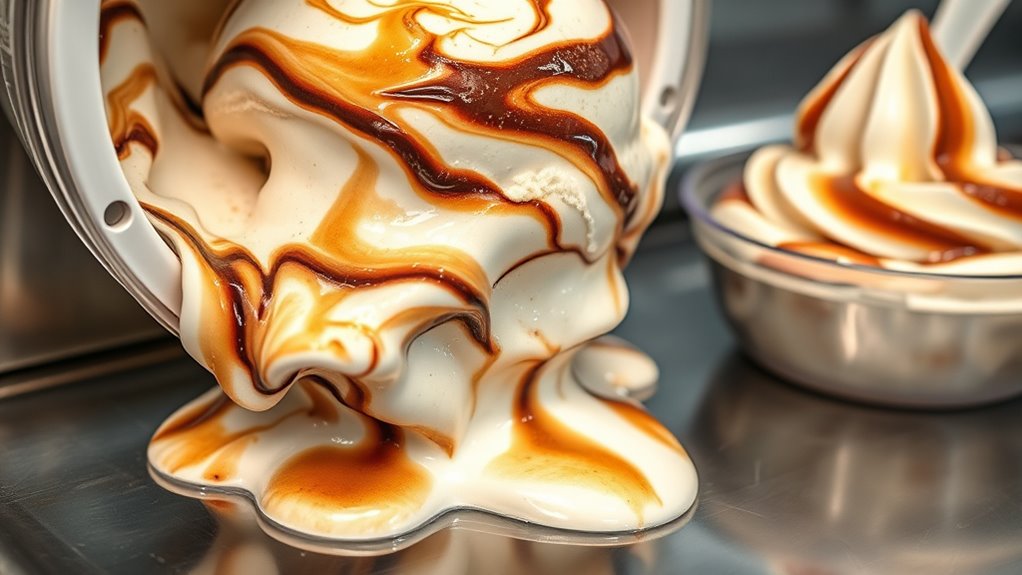
Filling the ice cream bowl to the right level is key for smooth freezing and ideal texture. Overfilling can cause spillage and strain the motor, while underfilling might result in inconsistent churning. Make sure you leave enough space for expansion and that your freezer has enough room for the machine to operate effectively. Proper bowl capacity management is essential for optimal performance. Additionally, ensuring your appliance compatibility with your freezer setup can prevent operational issues.
Proper Fill Levels
Guaranteeing the ice cream bowl is filled to the correct level is essential for peak machine performance. Overfilling can cause leaks and strain the motor, while underfilling leads to inconsistent texture and wasted product. Proper fill levels help maintain ideal operation and ensure your ice cream stays smooth and delicious. To get it right:
- Keep the bowl filled just enough to cover the churn blades without overflowing
- Use consistent fill levels to achieve uniform ice cream texture
- Experiment with ice cream flavor combinations and serving suggestions without overloading the bowl
- Regularly check the machine’s specifications to ensure you’re adhering to recommended fill levels for optimal performance
Avoid Overfilling Risks
Maintaining the right fill level isn’t just about avoiding spills; it’s also about preventing potential damage to your machine. Overfilling can cause the ice cream to overflow, leading to messes and strain on the motor. It might also interfere with proper churning, resulting in inconsistent textures. To avoid this, fill the bowl to the recommended level, leaving room for expansion and mixing. This ensures smooth operation and ideal flavor combinations. Overfilling can also limit your serving suggestions—if the machine can’t handle the extra volume, you miss out on creating larger batches for parties or family gatherings. Stick to the guidelines to keep your machine running efficiently and produce perfectly textured ice cream every time. Proper filling helps you enjoy a variety of flavors without risking damage or messes. Additionally, understanding the tuning of your machine can optimize performance and longevity, especially when considering the capacity for different models. Being aware of your machine’s robotic components and how they operate can further help in maintaining consistent results and avoiding malfunctions. Regularly cleaning and inspecting the stirring mechanism can also prevent buildup that may affect the consistency of your ice cream. Paying attention to the safety features can also help prevent accidents and ensure safe operation during use.
Ensuring Freezer Space
To get the best results from your ice cream machine, you need to pay close attention to your freezer space. Proper freezer organization guarantees there’s enough room for your ingredients without overfilling or underfilling the ice cream bowl. Avoid blocking vents or crowding the freezer, which can affect performance. Use storage containers to neatly stack and maximize space. Keep ingredients in clear containers so you can easily see what’s available. Regularly reassess your freezer layout to prevent overfilling, which can hinder freezing efficiency. Conversely, underfilling can cause uneven freezing. Maintaining a well-organized freezer with the right storage containers helps ensure consistent results and easy access to everything you need. Proper space management is key for smooth ice cream making. Additionally, understanding freezer temperature settings helps optimize freezing performance and prevent spoilage. Ensuring good air circulation within your freezer is essential for maintaining consistent temperatures and avoiding hot spots that can compromise your ice cream. It’s also important to monitor humidity levels inside the freezer, as excess moisture can lead to ice buildup and affect freezing quality. Regularly cleaning your freezer and defrosting when necessary can also improve overall performance and prevent mold or bacteria growth.
Not Allowing the Machine to Fully Freeze Before Use
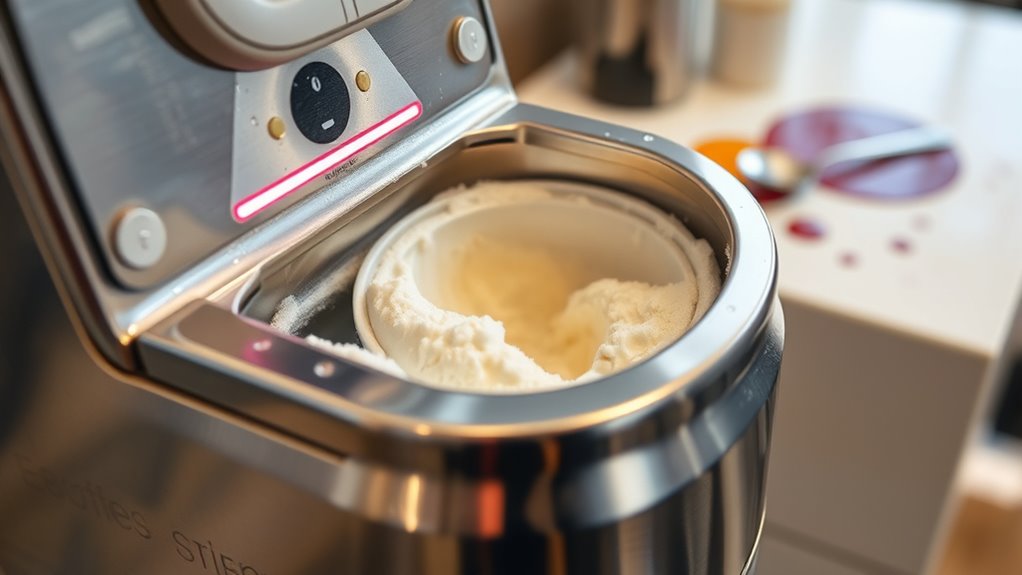
If you don’t give your ice cream machine enough time to fully freeze before use, it can lead to poor results. Proper temperature calibration guarantees the machine reaches the ideal freezing point, so don’t skip this step. Rushing the process means the bowl or compressor isn’t cold enough, resulting in ice cream that’s too soft or icy. Additionally, ingredient freshness plays a critical role; even with a fully frozen machine, old or warm ingredients won’t churn properly. Make sure your machine is completely frozen according to the manufacturer’s instructions before starting. This allows the cold environment to do its job effectively, producing smooth, creamy ice cream. Ensuring proper filtration technology can also help maintain the right internal environment for optimal freezing. Regular maintenance and cleaning of your machine, including checking the cooling system, can prevent temperature inconsistencies that compromise texture and flavor. Skipping this step compromises texture and flavor, no matter how fresh your ingredients are.
Skipping the Pre-Freezing Step of the Bowl (for Stationary Machines)
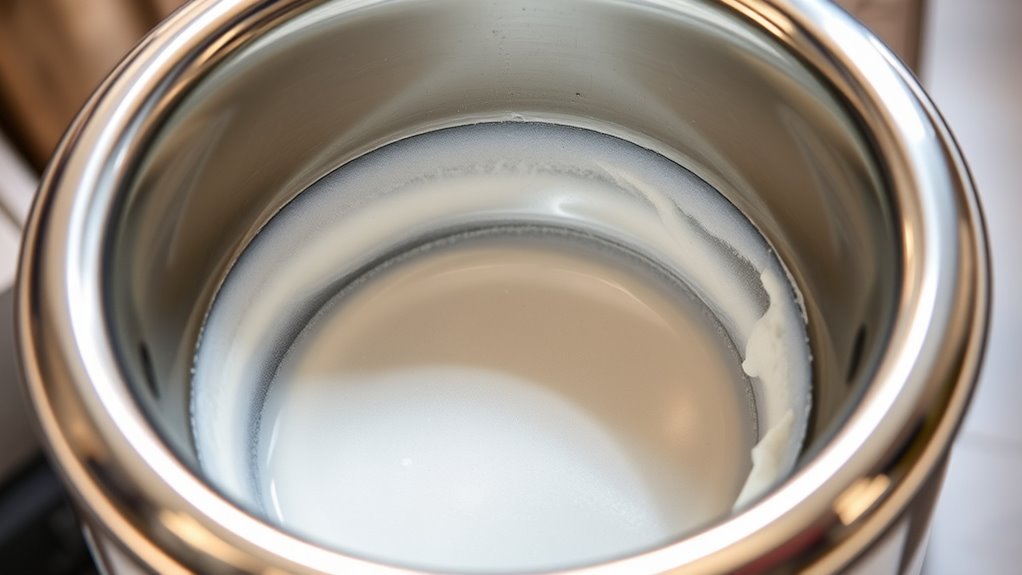
Skipping the pre-freezing step of the bowl in stationary ice cream machines can considerably impact your results. If you don’t pre freeze the bowls, your machine isn’t fully ready to produce smooth, creamy ice cream. Without properly pre freezing bowls, the mixture won’t chill quickly enough, leading to a less desirable texture and longer churning times. Ensuring your bowls are pre frozen is essential for machine readiness and ideal performance.
Skipping pre-freezing in stationary ice cream machines affects texture and churning time. Always pre freeze for best results.
To get the best results, remember:
- Always pre freeze your bowls for 12-24 hours before use
- Avoid rushing the pre-freezing process
- Use the right size bowls for your machine’s capacity
Neglecting this step can ruin the consistency, so don’t skip it!
Ignoring the Importance of Proper Mixing During Churning
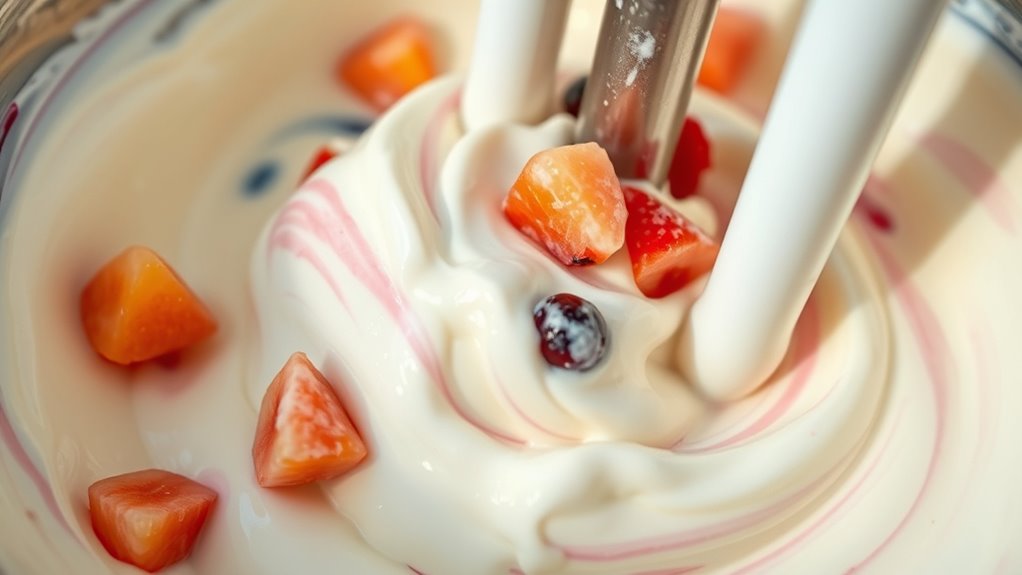
Proper mixing during churning is essential for achieving smooth, evenly textured ice cream. If you ignore this step, you risk uneven mixing consistency, which can lead to icy pockets or overly soft spots. Consistent agitation ensures ingredients are fully integrated, preventing separation and ensuring every scoop has balanced flavor and texture. When you don’t pay attention to mixing, ingredients like sugar, flavorings, and stabilizers may not blend properly, resulting in inconsistent taste. Additionally, proper mixing promotes uniform freezing, which helps develop the ideal creamy mouthfeel. Skipping or rushing this step can compromise the final product’s quality, leaving you with ice cream that’s less enjoyable. Focus on steady, even mixing to maximize ingredient integration and get the best possible results from your machine.
Rushing the Churning Process
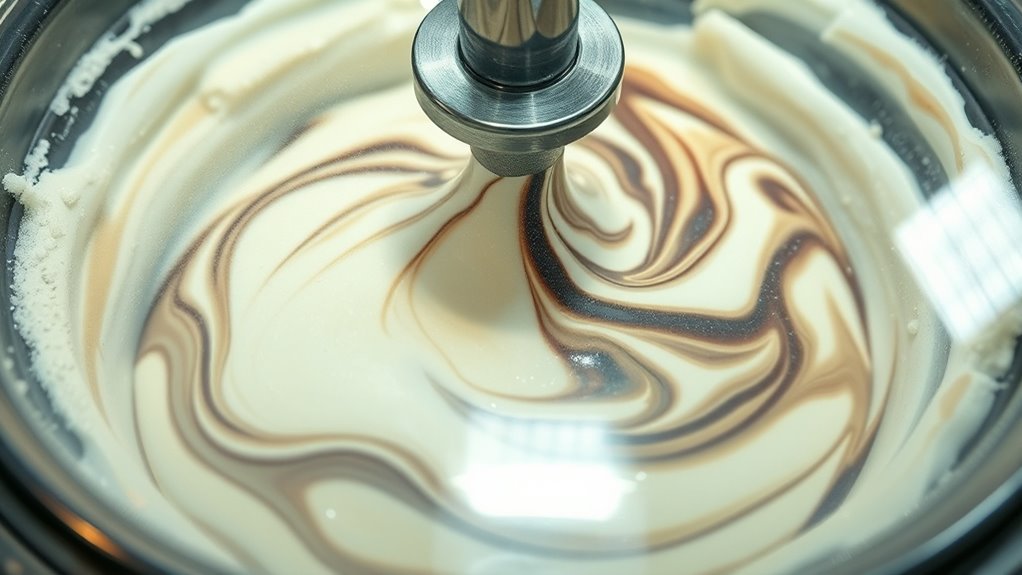
Rushing the churning process can substantially compromise the quality of your ice cream. When you speed up the churn cycle too much or skip rest periods, your ice cream may turn out icy, grainy, or lacking a smooth texture. Pushing the machine to churn faster doesn’t give the ingredients enough time to blend properly or develop the right structure.
Be mindful of these common mistakes:
- Ignoring recommended churning times for faster results
- Constantly speeding the churn cycle without breaks
- Skipping rest periods that allow the mixture to thicken naturally
Taking these shortcuts might seem efficient, but they often ruin the final product. Patience guarantees your ice cream is creamy, smooth, and perfectly textured.
Failing to Store Ice Cream Properly After Making

If you don’t store your ice cream correctly after making it, its texture and flavor can quickly deteriorate. Improper storage exposes your ice cream to temperature fluctuations, which can cause ice crystals to form and compromise texture preservation. To maintain flavor consistency, keep your ice cream in an airtight container to prevent it from absorbing freezer odors. Place it in the coldest part of your freezer, ideally at a steady 0°F (-18°C), and avoid frequent opening. Wrapping the container tightly minimizes air exposure, preventing freezer burn that ruins both texture and taste. Proper storage guarantees your homemade ice cream stays creamy and flavorful for longer, making every scoop as delicious as the first. Don’t overlook this step if you want to enjoy perfect ice cream every time.
Frequently Asked Questions
How Often Should I Perform Maintenance on My Ice Cream Machine?
You should perform maintenance on your ice cream machine regularly to keep it running smoothly. Follow a strict machine cleaning schedule, ideally after each use, to prevent buildup and guarantee proper hygiene. Regularly check and clean parts like the dasher and freezing cylinder. When adding ice cream flavorings, make sure everything is thoroughly cleaned beforehand. Consistent maintenance helps avoid flavor contamination and extends your machine’s lifespan.
Can Ingredient Substitutions Affect the Texture of My Ice Cream?
You might think ingredient swaps won’t matter, but they can substantially impact your ice cream’s texture. Substituting ingredients like cream or sugar affects creaminess, smoothness, and consistency, proving that even small changes matter. So, when you make ingredient substitutions, consider how they might influence texture impact. This awareness helps you create the perfect batch, ensuring your ice cream remains creamy and satisfying, no matter what ingredient swaps you make.
What Signs Indicate My Ice Cream Base Hasn’t Chilled Enough?
You’ll notice your ice cream base hasn’t cooled enough if it’s still warm or uneven in temperature, which affects texture. Check for temperature consistency by using a thermometer—ideally, it should be below 40°F. Also, if your mixture is still runny despite mixing, it needs more chilling time. Maintain steady mixing speed to avoid aeration and ensure even cooling, so your base chills thoroughly before churning.
How Do I Know if My Ice Cream Bowl Is Properly Pre-Frozen?
Imagine you’re about to make ice cream, and your bowl feels icy to the touch. That’s a good sign your bowl has undergone proper pre freezing duration and achieved ideal bowl cooling. Typically, leaving your bowl in the freezer for at least 12 hours ensures it’s ready. If it’s still warm or only slightly chilled, it’s not properly pre frozen, which can affect your ice cream’s texture.
What’s the Best Way to Store Leftover Ice Cream for Freshness?
For proper ice cream storage and leftover preservation, always transfer your ice cream to an airtight container to prevent freezer burn and ice crystals. Keep the container in the coldest part of the freezer, and try to consume leftovers within a week for peak freshness. Avoid leaving the container open for long periods, and reseal tightly after each use. These steps help maintain your ice cream’s creamy texture and flavor.
Conclusion
Just like Icarus who flew too close to the sun, neglecting these ice cream tips can cause your masterpiece to melt away. When you take the time to clean, chill, and follow each step, you’re honoring the craft and ensuring your frozen creations stand tall. Don’t let hurried mistakes be the fall of your sweet success. Embrace patience and care—your perfect scoop awaits, ready to delight with every bite.



